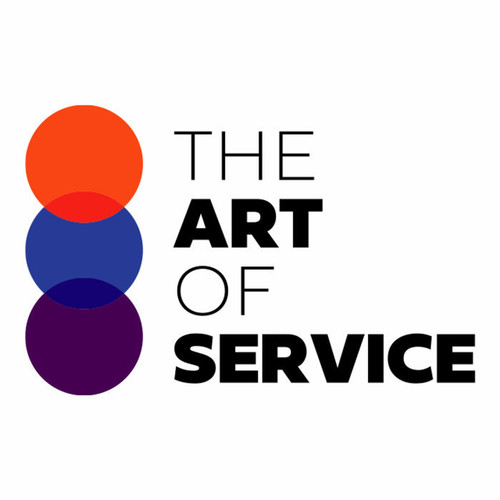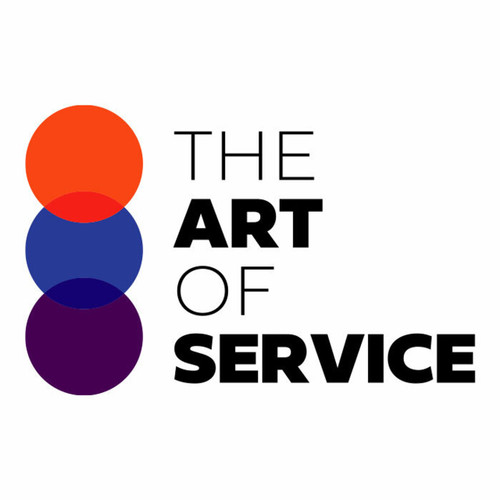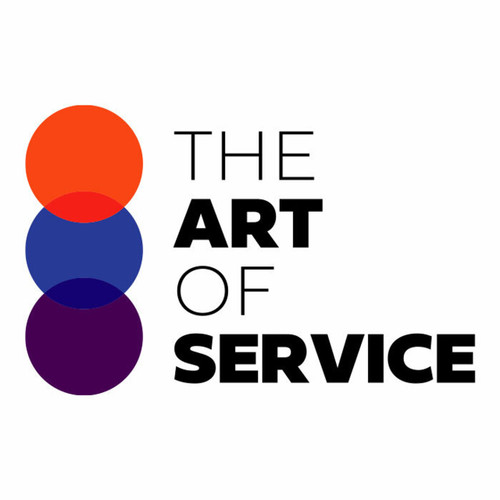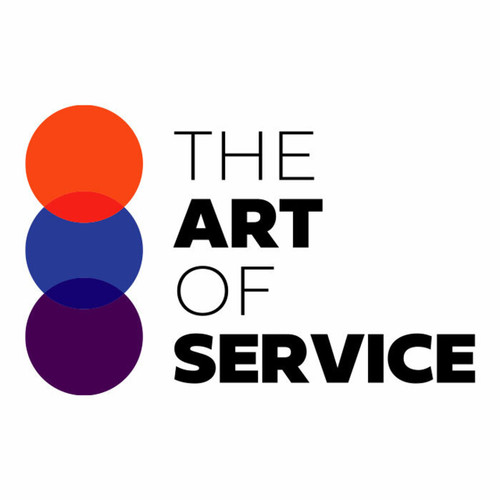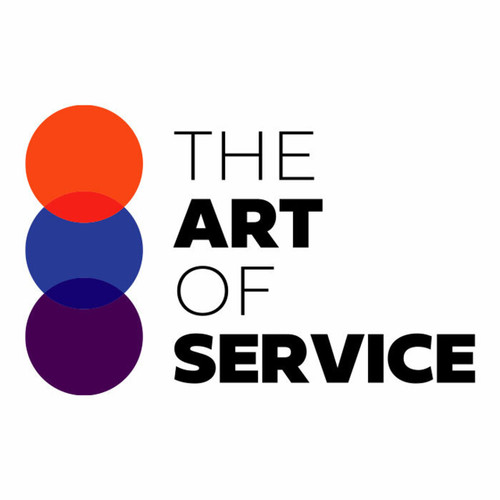That′s where our Augmented Reality and Future of Work Knowledge Base comes in.
With a dataset of 1518 prioritized requirements, solutions, benefits, and case studies, our Knowledge Base is the ultimate resource for anyone looking to navigate the shifting landscape of work.
Our database includes the most important questions to ask, organized by urgency and scope, so you can get results quickly and efficiently.
But what sets our Knowledge Base apart from competitors and alternatives? Our comprehensive yet concise dataset covers everything from Augmented Reality and Future of Work solutions to concrete examples of how they′ve been implemented in real-life use cases.
No other product offers such a holistic approach and detailed insights into this rapidly evolving field.
Our Knowledge Base is designed specifically for professionals and businesses, making it the perfect tool to stay ahead of the competition.
And with its user-friendly interface and DIY/affordable options, it′s accessible to everyone, regardless of technical expertise or budget.
Still not convinced? Consider the benefits our Knowledge Base provides.
Not only will it save you time and resources by streamlining your research process, but it also offers invaluable insights and strategies to fully leverage the power of augmented reality and the future of work.
It′s a must-have for any organization looking to thrive in today′s fast-paced environment.
And let′s talk cost.
Our Knowledge Base is a fraction of the price of hiring a consultant or conducting your own research.
Plus, with its comprehensive coverage and up-to-date information, it′s a cost-effective way to stay informed and ahead of the curve.
So why wait? Don′t miss out on the opportunity to unlock the full potential of augmented reality and the future of work.
Get your hands on our Knowledge Base today and start reaping the benefits for your business.
With its detailed product specifications, user-friendly interface, and cost-effective pricing, it′s a no-brainer.
Take the first step towards success in the age of automation, robotics, and virtual reality with our Augmented Reality and Future of Work Knowledge Base.
Discover Insights, Make Informed Decisions, and Stay Ahead of the Curve:
Key Features:
Comprehensive set of 1518 prioritized Augmented Reality requirements. - Extensive coverage of 151 Augmented Reality topic scopes.
- In-depth analysis of 151 Augmented Reality step-by-step solutions, benefits, BHAGs.
- Detailed examination of 151 Augmented Reality case studies and use cases.
- Digital download upon purchase.
- Enjoy lifetime document updates included with your purchase.
- Benefit from a fully editable and customizable Excel format.
- Trusted and utilized by over 10,000 organizations.
- Covering: Video Conferencing, Remote Team Building, Co Working Spaces, Workforce Diversity, Remote Working, Work From Anywhere, Flexibility In The Workforce, Cognitive Computing, Online Collaboration Tools, Digital Transformation, Virtual Meetings, Work Life Harmony, Cloud Computing, Robotic Process Automation, Wearable Technology, Artificial Intelligence In HR, Remote Workforce Management, Digital Meetings, Robotic Workforce, Work Life Balance, Digital Onboarding, Workforce Planning In The Digital Age, Remote Access, Technological Advancements, Blockchain In Human Resources, Remote Job Opportunities, Flexible Work Environment, Human Machine Interaction, Adaptive Leadership, Employee Well Being, Digital Skills Gap, Future Workforce, Automation In Healthcare, Intelligent Automation, Future Of Work, Artificial Intelligence Ethics, Productivity Apps, Virtual Assistants, Artificial Intelligence In Education, Digital Nomads, Digital Marketing Strategies, Smart Offices, Augmented Learning, Internet Of Things, Augmented Reality Implementation, Future Of Education, Collaborative Innovation, Remote Management, Virtual Team Building, Cybersecurity Training, Remote Work Productivity, AI Powered Personalization, Distributed Teams, Global Workforce, Virtual Reality Education, Collaborative Platforms, Distributed Workforce, Digital Communication Tools, Virtual Reality Shopping, Flexible Workforce Models, New Job Roles, Virtual Training Programs, Augmented Workforce, Personalized Learning, Virtual Reality Therapy, Smart Contracts, Flexible Work Arrangements, Teleworking Solutions, Cybersecurity For Remote Work, Automation And Ethics, Future Of HR, Cybersecurity Concerns, Remote Workforce Engagement, Data Privacy, Chatbots In Customer Service, BYOD Security, Mobile Workforce, Digital Payment Methods, Smart Workforce Management, Automation In The Workplace, Robotics In Manufacturing, Workforce Analytics, Virtual Collaboration, Intelligent Assistants, Virtual Work Environment, Predictive Analytics, Cloud Computing In The Workplace, Remote Work Benefits, Digital Work Life, Artificial Intelligence, Augmented Reality Marketing, Online Platforms For Work, Millennial Workforce, Virtual Reality Training, Machine Learning Integration, Voice Recognition Technology, Collaborative Robots, Automated Supply Chain, Human Machine Collaboration, Work From Home Productivity, Remote Teams, Workplace Collaboration Tools, Innovation In The Workplace, Flexible Hours, Collaboration Tools, Data Privacy In Remote Work, 5G Technology Impact, Augmented Reality, Digital Transformation In The Workplace, Artificial Intelligence In The Workplace, Cloud Based Collaboration, Digital Skills, Automation In Customer Service, Data Analytics For Workforce Management, Collaboration In The Cloud, Augmented Reality Advertising, Remote Work Strategies, Remote Work Best Practices, Telecommuting Benefits, Digital Workplace Culture, Learning Platforms, Collaborative Spaces, Smart Homes, Data Driven Decision Making, Workforce Mobility, Workplace Wellness, Digital Branding, Flexible Work Schedule, Remote Work Challenges, Automation Impact, Gig Economy, Transparency In Automated Decision Making, Productivity Hacks, Hybrid Workforce, Smart Cities, Automation Testing, Virtual Team Communication, Smart Office Spaces, Digital Disruption, Work Life Integration, Smart Buildings, Work And Technology Integration, Gamification In The Workplace, Workforce Empowerment, Emotional Intelligence In The Workplace, Flexible Workspaces, AR Workplace, Human Centered Design, Data Security In Remote Work, Virtual Talent Acquisition, Telecommuting Trends
Augmented Reality Assessment Dataset - Utilization, Solutions, Advantages, BHAG (Big Hairy Audacious Goal):
Augmented Reality
Yes, there should be restrictions to protect personal privacy and prevent misuse of data collected by emerging technologies in public spaces.
1. Implement regulations on the use of augmented reality (AR) technology to protect individual privacy.
-This would prevent sensitive personal data from being captured and used without consent.
2. Develop technology to blur or block out specific areas or objects in public spaces from being captured by AR.
-This could help maintain a sense of privacy and preserve the integrity of public spaces.
3. Educate the public on how AR technology works and its potential impact on their privacy.
-This would increase awareness and encourage individuals to be more cautious about their surroundings.
4. Encourage companies to be transparent about their use of AR technology and how they handle captured data.
-This would foster trust and accountability in the use of emerging technologies.
5. Have clear guidelines on the ethical use of AR technology, particularly in sensitive locations such as hospitals or schools.
-This would ensure that AR is used for the benefit of society and not for harm or exploitation.
6. Create a mechanism for individuals to easily report any misuse or unethical use of AR technology.
-This would provide a way for individuals to hold companies accountable for their actions.
7. Utilize encryption and security protocols to protect captured data from being accessed or used by unauthorized parties.
-This would safeguard sensitive personal information and prevent data breaches.
8. Conduct regular audits and reviews of companies using AR technology to ensure compliance with data privacy laws.
-This would help identify and address any potential violations or misuse of data.
9. Incorporate AR ethics and privacy training into professional development programs for those working with AR technology.
-This would promote responsible use of AR technology and mitigate potential harm to individuals.
10. Foster collaboration between policymakers, businesses, and technology experts to continuously evaluate and update regulations around AR technology.
-This would ensure that laws and policies keep up with the fast-paced advancements in technology and protect the public′s interest.
CONTROL QUESTION: Should there be restrictions on what data emerging technologies can capture from public spaces?
Big Hairy Audacious Goal (BHAG) for 10 years from now:
BHA Augmented Reality Goal: Within the next 10 years, Augmented Reality technology will be seamlessly integrated into our daily lives, enhancing our physical surroundings and revolutionizing the way we interact with the world.
Utilizing advanced AR devices and software, we will be able to access a wealth of information and virtual objects in real-time, enabling us to make informed decisions, learn new skills, and experience new worlds without ever leaving our homes.
Retail stores will become immersive shopping experiences, where we can try on clothes, test products, and visualize how items will look in our own homes before purchasing. Virtual classrooms will allow students to travel to historical events and distant planets, improving learning retention and engagement. Emergency response teams will use AR to navigate disaster zones and perform life-saving procedures with greater accuracy.
In entertainment, AR will blur the lines between reality and fiction, bringing games and movies to life like never before. In healthcare, doctors will be able to provide remote consultations and surgeries using AR technology, making it easier to access medical care for those in remote areas.
This BHA goal will not only change the way we live, work, and play, but it will also bring us closer together as a global community by breaking down language barriers and allowing us to connect with people from different cultures and backgrounds.
However, with the incredible power and reach of AR, there must come responsibility. That′s why in addition to this goal, we must also set restrictions on what data emerging technologies can capture from public spaces.
Privacy and security must be at the forefront of AR development, with strict regulations in place to protect individuals′ personal data. Facial recognition technology should not be used without consent, and sensitive information should not be collected without explicit permission.
Furthermore, ethical considerations must be taken into account when using AR in public spaces. Companies and organizations must ensure that their use of AR is not invasive or discriminatory towards certain individuals or groups.
In conclusion, by setting this bold and ambitious goal for AR, we also need to recognize the importance of responsible and ethical use of this technology. By achieving this balance, we can truly harness the full potential of AR and create a better future for all.
Customer Testimonials:
"This dataset has saved me so much time and effort. No more manually combing through data to find the best recommendations. Now, it`s just a matter of choosing from the top picks."
"The creators of this dataset deserve applause! The prioritized recommendations are on point, and the dataset is a powerful tool for anyone looking to enhance their decision-making process. Bravo!"
"The prioritized recommendations in this dataset are a game-changer for project planning. The data is well-organized, and the insights provided have been instrumental in guiding my decisions. Impressive!"
Augmented Reality Case Study/Use Case example - How to use:
Synopsis of Client Situation:
The client, a large multinational technology company, is currently developing an Augmented Reality (AR) platform that utilizes advanced computer vision and machine learning algorithms to enhance the user’s real-world experience. The platform is designed to overlay digital information onto the user’s physical surroundings, providing them with a more immersive and interactive experience. However, as this technology becomes more prevalent in public spaces, concerns have been raised about the potential for data to be collected and stored without the consent or knowledge of individuals. The client has approached our consulting firm to conduct a thorough analysis of the ethical implications surrounding the use of AR in public spaces and make recommendations on whether there should be restrictions on what data can be captured.
Consulting Methodology:
Our consulting methodology will follow a three-step process: research, analysis, and recommendation. The research phase will involve reviewing current literature, consulting whitepapers, academic business journals, and market research reports to understand the current landscape of AR technology and its use in public spaces. This will also include conducting interviews and surveys with key stakeholders such as government regulators, privacy experts, and potential users of AR technology.
In the analysis phase, we will assess the potential risks and benefits of allowing unrestricted data collection from public spaces. This will involve evaluating the legal, ethical, and social implications, as well as the potential impact on the industry and the public.
Based on our research and analysis, we will make recommendations on whether there should be restrictions on what data can be captured from public spaces and provide guidelines for responsible use of AR technology in these settings.
Deliverables:
- A comprehensive report with a summary of our research findings and analysis.
- Recommendations for regulations and guidelines for the use of AR technology in public spaces.
- A presentation to the client highlighting the key points from our report and recommendations.
Implementation Challenges:
One of the main challenges in implementing our recommendations may be resistance from the technology industry. AR technology companies may be hesitant to accept restrictions on their data collection practices, as it may limit the potential for innovation and growth. There may also be challenges in enforcing regulations and ensuring compliance from all AR technology providers.
KPIs:
- Number of regulations and guidelines implemented by governments and industry bodies.
- Level of compliance from AR technology companies.
- Public perception and trust in AR technology industry.
- Number of privacy complaints or breaches reported related to AR technology.
Management Considerations:
- Collaboration with government regulators and industry experts will be crucial in developing effective regulations and guidelines.
- Education and outreach programs may be necessary to increase public awareness and understanding of AR technology and its potential impact on privacy.
- Ongoing monitoring and evaluation of the effectiveness of regulations and guidelines will be necessary to ensure they are keeping up with advancements in AR technology.
Conclusion:
In conclusion, our findings suggest that there should be restrictions on what data emerging technologies such as AR can capture from public spaces. While AR technology has the potential to enhance user experiences, it is important to consider the legal, ethical, and social implications and ensure that privacy rights are respected. Our recommendations will provide a balanced approach towards regulating the use of AR in public spaces and help build trust between the technology industry and the public.
Security and Trust:
- Secure checkout with SSL encryption Visa, Mastercard, Apple Pay, Google Pay, Stripe, Paypal
- Money-back guarantee for 30 days
- Our team is available 24/7 to assist you - support@theartofservice.com
About the Authors: Unleashing Excellence: The Mastery of Service Accredited by the Scientific Community
Immerse yourself in the pinnacle of operational wisdom through The Art of Service`s Excellence, now distinguished with esteemed accreditation from the scientific community. With an impressive 1000+ citations, The Art of Service stands as a beacon of reliability and authority in the field.Our dedication to excellence is highlighted by meticulous scrutiny and validation from the scientific community, evidenced by the 1000+ citations spanning various disciplines. Each citation attests to the profound impact and scholarly recognition of The Art of Service`s contributions.
Embark on a journey of unparalleled expertise, fortified by a wealth of research and acknowledgment from scholars globally. Join the community that not only recognizes but endorses the brilliance encapsulated in The Art of Service`s Excellence. Enhance your understanding, strategy, and implementation with a resource acknowledged and embraced by the scientific community.
Embrace excellence. Embrace The Art of Service.
Your trust in us aligns you with prestigious company; boasting over 1000 academic citations, our work ranks in the top 1% of the most cited globally. Explore our scholarly contributions at: https://scholar.google.com/scholar?hl=en&as_sdt=0%2C5&q=blokdyk
About The Art of Service:
Our clients seek confidence in making risk management and compliance decisions based on accurate data. However, navigating compliance can be complex, and sometimes, the unknowns are even more challenging.
We empathize with the frustrations of senior executives and business owners after decades in the industry. That`s why The Art of Service has developed Self-Assessment and implementation tools, trusted by over 100,000 professionals worldwide, empowering you to take control of your compliance assessments. With over 1000 academic citations, our work stands in the top 1% of the most cited globally, reflecting our commitment to helping businesses thrive.
Founders:
Gerard Blokdyk
LinkedIn: https://www.linkedin.com/in/gerardblokdijk/
Ivanka Menken
LinkedIn: https://www.linkedin.com/in/ivankamenken/



